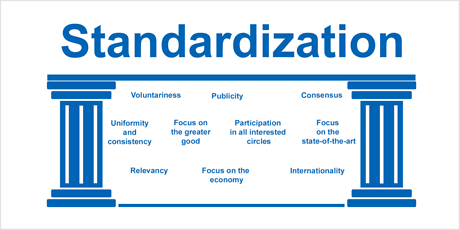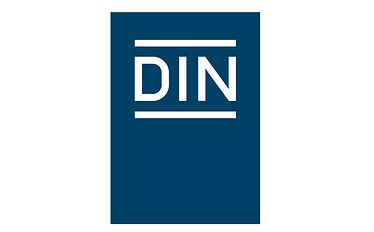What does full consensus standardization mean? Full consensus standardization is a process in which material and immaterial objects are standardized by consensus for the benefit of society as a whole. That means that all groups that are interested in the topic participate in the process, systematically and cooperatively, the public is involved (cf. DIN 820-3:2014-06, 3.1.3.1.) and consequently there is the highest possible level of acceptance of the results.
Basics of Standardization
Full consensus standardization and limited consensus standardization - definition and difference
Full consensus standardization and limited consensus standardization are often used in the same context. There is, however, a clear distinction between the definitions of the two processes and terms which must be known and taken into account:
10 Principles of standardization

10 Principles of standardization
| DKEShort and sweet – a brief explanation of standards
What are standards?
A standard is, by definition, a document that lays down and establishes rules for products, processes, technologies or services.
A standard is usually non-binding and is available for voluntary use unless its application is required by legislation or contracts. With its specified rules, it acts as a guide and as recognized expertise in legal decision. A synonym such as "guideline" or "recommendation for action" therefore very aptly describe what a standard is and what its characteristics are.
There are many examples of standards as they are developed for many sectors by various organizations. To name only one of those examples, there are DIN VDE standards. We, the DKE, are responsible for those standards as a DIN standards committee and part of the VDE. We develop regulations and directives for the fields of electrical engineering, electronics and information technology on behalf of VDE. They are ultimately labeled and published as VDE standards.
Why are standards important?
The objectives of standards are to create safety, interchangeability and compatibility to increase efficiency and productivity with a high level of acceptance. That's what makes them so important. It is through their extensive development and application that standards as well as specifications promote cooperation on the market. They standardize processes, improve communication through clear specifications and structures and thus break down trade barriers. Standards achieve economic objectives at this point, like facilitating and accelerating the movement of goods. Standards are also important for the general public as they make devices and systems safe, high-quality and compatible which increases user friendliness and customer satisfaction.
The purpose of standardization is also clear in every other area: It is necessary and important for fundamental objectives pertaining to the environment, science and government.
Learn more about the topic at
Important basics
Where can I find information about standardization plans and projects?
In order for the standardization process to function in everyone’s interest, the public must be informed of the adoption of new standardization work, the revision of existing standards, the rejection of standardization petitions and the completion of standardization projects. This and more is available on our website, via etz – elektrotechnik & automation and at DIN via the DIN Anzeiger für technische Regeln (Journal for Technical Regulations). You can get information there anytime.
Why are standards harmonized?
To answer the question as to why standards are harmonized it must first be noted that in this case there are two areas, which although conceptually similar, must be differentiated with respect to their tasks and purpose. On the one hand there is the “harmonization of standards” and, on the other, “harmonized standards”.
What is the objective of harmonizing standards and why does it exist?
There is an obligation to adopt European standards as national standards while simultaneously withdrawing contradictory national standards. This is referred to as harmonization. The adoption of European standards as national standards must take place in all 34 European member countries of CENELEC, whilst the actual application of the standards remains voluntary. The objective is to increase uniformity with respect to the standards in Europe in order to strengthen the European Single Market and break down non-tariff trade barriers.
What are harmonized standards and why do they exist?
To achieve the fundamental protective objectives of devices, systems, etc., European standards are defined that technically describe the necessary measures and framework conditions.
If such a standard is listed and published by the European Union in the Amtsblatt (Official Journal), it is assigned the status of a harmonized standard.
The listing in the Official Journal and the related status as a harmonized standard result in a so-called presumption of conformity which allows users of the listed standard to assume that they are acting in a technically faultless manner. By implication, referencing harmonized standards also results in trust and credibility among consumers. The benefit to users of standards/manufacturers is also, for instance, in the product liability process. If harmonized standards are applied and thus all necessary, reviewed regulations and conditions are fulfilled, the manufacturer is released from culpability in the event of accidents occurring during the use of the device or product.
Who develops standards?
Fundamentally, a group of experts from, as many interested parties as possible develop standards and specifications together. This is referred to as a “body”. Our technical experts come from consumer, service provider, scientific and/or governmental organizations. Within their respective "bodies", they develop standards and specifications and take into consideration all concerns and objections as part of a dialog in order to take all interests into account. A body develops standards based on the practical knowledge of the involved experts. They contribute their experience and expertise from their respective branches to the standardization work. In this manner, the body develops results that are as current as possible and which are supported by everyone. The group of experts sets standards by consensus and presents these results to the public in draft form. The shared objective is to develop a consensus-based, generally recognized, market-oriented, technically up-to-date set of rules and guidelines that are ultimately published by the committee responsible.
Anyone can submit a petition for standards and specifications. In their "bodies", experts develop draft standards for these petitions in a multi-stage procedure, in a democratic manner, before they are finally adopted.
How are standards created?
To understand standards as a whole, it is in turn necessary to find out about how they are created and how the standardization process works. Standards are in principle created by consensus in a multi-stage procedure in a democratic manner and taking all affected groups into account. From the petition to the passing of the standard, it is possible at specific times to submit an objection to the planned new rule. A public objection procedure with fixed deadlines decides at the beginning whether a standardization petition will be granted so that at the end of the process there is a generally “recognized rule of technology” (Paragraph 49 of the Energiewirtschaftsgesetz (Energy Management Act)).
Although the standardization process slightly differs depending on the nature of the process and organization responsible for it, the essential basics are the same in all variants. They can be divided into four specific steps, which can be used to roughly illustrate how standardization works:
- Submitting a standardization petition/idea
- Developing a draft standard
- Public statement on the draft standard
- If generally approved: Creation of the finished standard for acquisition
Anyone who is interested can participate in the standardization and submit a standardization petition for a new standard. You can submit petitions for new national, European or international standardization work or the revision of existing standards to us, DIN or, if known, the competent standardization committee.
In the bodies, several votes are held on the newly developed standards or drafts before technical journals publish the draft standard in the final step. From this point on, every citizen has the right to object within a given time limit. If there are objections from individuals, the body must give them the opportunity to present their criticism.
It sometimes takes a long time before a standard is published. We therefore offer publication formats in which standards are created and presented to the general public within a short period of time for particularly dynamic future markets like electromobility and information and telecommunications technologies (ICT). These are known as specifications and are developed based on defined rules. They include guidelines and VDE application rules. They fulfill the high demands of the VDE’s body of regulations and allow for a significantly faster publication process.





